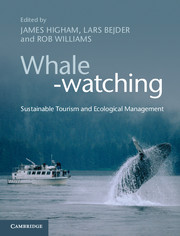Book contents
- Frontmatter
- Dedication
- Contents
- Acknowledgements
- List of contributors
- List of abbreviations
- 1 Tourism, cetaceans and sustainable development
- Part I The historical and contemporary contexts
- Part II Human dimensions of whale-watching
- Part III Ecological dimensions of whale-watching
- Part IV Sustainable management: insights and issues
- Index
- Plate Section
- References
1 - Tourism, cetaceans and sustainable development
Moving beyond simple binaries and intuitive assumptions
Published online by Cambridge University Press: 05 April 2014
- Frontmatter
- Dedication
- Contents
- Acknowledgements
- List of contributors
- List of abbreviations
- 1 Tourism, cetaceans and sustainable development
- Part I The historical and contemporary contexts
- Part II Human dimensions of whale-watching
- Part III Ecological dimensions of whale-watching
- Part IV Sustainable management: insights and issues
- Index
- Plate Section
- References
Summary
The majestic aspects of whales – their size; the apparent intelligence of some whales; the songs of others – led to rediscovery of the old iconography – whales as magnificent in their own right
(Corkeron, 2006: 161)Introduction
Of the few iconic experiences available in the natural world, little compares to killer whales (Orcinus orca) outwitting and overpowering their prey, a cooperative group of feeding humpback whales (Megaptera novaeangliae), the flukes of a diving sperm whale (Physeter macrocephalus) or the spectacular aerial displays of socializing bottlenose dolphins (Tursiops sp.). These stunning megafauna experiences explain the widespread rejection of whale hunting and the phenomenal growth of whale-watching in recent decades (Hoyt, 2001; O’Connor et al., 2009; Cisneros-Montemayor et al., 2010). Under the circumstances, it is remarkable that these animals, and indeed all species of cetaceans (whales, dolphins and porpoises), vary so widely in the legal and management protection they receive in jurisdictions around the world.
Cetaceans trigger sentiments of awe, inspiration and excitement. ‘Few creatures carry more emotion…than whales; and few issues arouse as much passion as whaling’ (Hammond, 2006: 54). These emotions and passions give rise to deeply entrenched and, at times, bitterly conflicting views on whales in terms of utility, identity, nationhood and sovereignty. The sinking of the Ady Gil, flagship of the Sea Shepherd Conservation Society, while protesting against the Japanese whaling fleet in the Southern Ocean whale sanctuary in 2010 highlights these entrenched views. Few wildlife species are contested as intensely as whales.
- Type
- Chapter
- Information
- Whale-watchingSustainable Tourism and Ecological Management, pp. 1 - 16Publisher: Cambridge University PressPrint publication year: 2014
References
- 3
- Cited by

